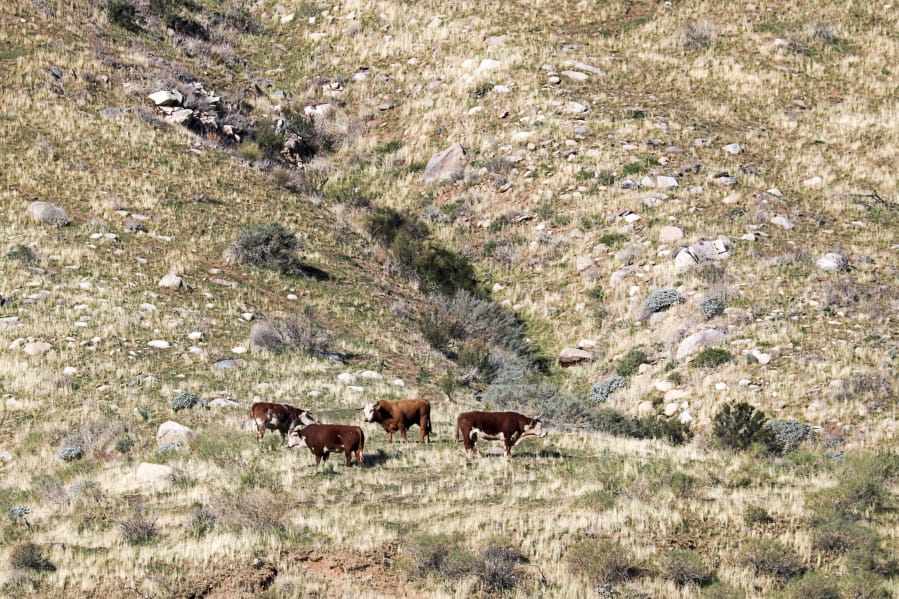SAND TO SNOW NATIONAL MONUMENT — Sand to Snow National Monument is a quiet place — its mountainous high desert and cascading streams a draw for those seeking panoramic views, tranquility and solitude.
But on a recent morning, the serenity was ruined by a menacing bellowing, making it clear passing hikers weren’t alone.
On a ridgeline near a popular stretch of the Pacific Crest Trail, five feral bulls, each the size of a small car, were snorting, stomping and pawing the ground — postures indicating they were ready to charge.
The bulls gazed down on human observers; some lowered their footlong horns. Then they lumbered on, trampling the trail and devouring native vegetation in one of California’s newest national monuments.
Peering through binoculars, Terry Anderson, a board member of the Society for the Conservation of Bighorn Sheep, saw a species he doesn’t consider worthy of conservation in the wild lands near Palm Springs.
“They are part of a herd of at least 150 that’s ripping up this monument and scaring the heck out of folks who cross paths with them,” he said. “They also can transmit disease to native bighorn sheep. So, they need to be removed — and I’m all for lethal removal. They don’t belong here.”
Signs posted at trailheads warn of an additional danger. A pack of pit bulls has been killing and eating wild cattle in this nature sanctuary framed by mountains and watered year-round by a river roiling through overlapping biological zones including sandy desert, boulder fields, grasslands and forests.
Jack Thompson, desert regional director of the adjacent Whitewater Preserve, roughly 10 miles northwest of Palm Springs, was only half-kidding when he said, “It’s Jurassic Park just a two-hour drive east of downtown Los Angeles.”
The conflicts have become a local crisis not just because of the wild cattle and dogs, but also because the number of visitors and hikers in the Mojave Preserve and Sand to Snow National Monument has increased dramatically since it received federal designation in 2016, up from 90,000 to 148,000 last year.
There are cattle, including some that are wild, spread across California’s millions of acres of open lands. But the size of this feral herd and its proximity to one of the most popular wilderness trails in the state make it a vexing problem for federal land managers. Because of a lack of cellphone service in portions of these canyon lands, it wouldn’t be easy to summon help in the event of a stampede or goring.
Conservation groups including the Pacific Crest Trail Association are urgently calling on federal land managers to take action.
The U.S. Forest Service and Bureau of Land Management, which co-manage the monument’s 101,000 acres as wilderness, said they plan in March to dispatch a team of federal land managers, biologists and representatives of the nearby Morongo Band of Mission Indians reservation to come up with a strategy and funds to eliminate the unbranded cattle and collarless dogs.
That process, however, could grind on for months because the animals are crossing jurisdictional boundaries of agencies and governments including the Forest Service’s San Bernardino National Forest, the Wildlands Conservancy’s Whitewater Preserve and the Morongo reservation. In addition, any effort to remove the animals must comply with myriad state and federal wildlife regulations.
California Fish and Wildlife authorities were unsuccessful in an attempt this year to lure the dogs into traps baited with food.
In the meantime, an estimated 150 feral cattle — roughly one-third of them bulls weighing as much as 2,000 pounds — are reshaping scenic canyons and slopes with their appetites and hooves. They are carving new trails and wiping out grasses that anchor soil.



